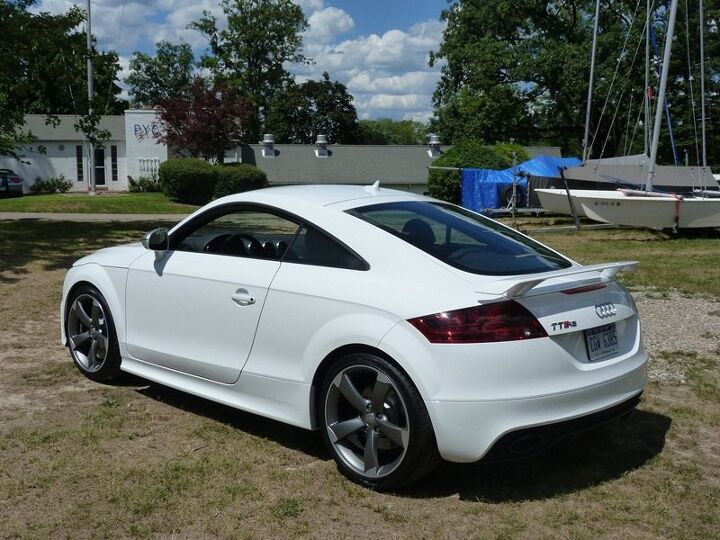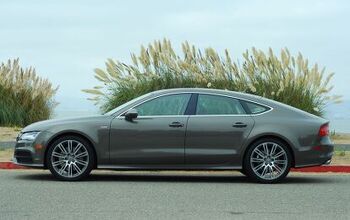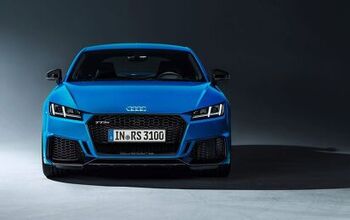Review: 2012 Audi TT RS
Anyone who’s been paying attention knows that the Audi TT is based on the VW Golf, which can be had for under $18,000. And it can seem silly when people buy an econobox then pour multiples of the purchase price into mods. When Audi does the same to create the $57,725 TT RS, how can we take the end result seriously?
Audiphiles will notice the subtle changes Audi has made to distinguish the RS from other TTs, and approve. The rest of us will see an Audi TT with a tasteful, non-retractable wing spoiler and gorgeous five-spoke alloy wheels. We might notice the enlarged intakes beneath the headlamps. There’s nothing to proclaim to those not in the know that they’re in the presence of a 360-horsepower bullet. Aside the big grille that started them all, outrageous styling details just aren’t the Audi way. The TT itself remains as iconic and beautiful as the day it sent car designers around the world racing back to their sketch pads. The car’s shape authentically communicates its front-engine, all-wheel-drive layout.
Little of the extra money over the $39,175 base TT went into the RS’s interior. The nappa seats (with faux suede center panels and contrasting stitching) and door panel inserts pass muster, but much of the rest looks and feels suited to a car half the TT RS’s price. Such is the danger with any special performance model where over $16,000 goes towards upgraded hardware. This said, little seems cheap, just purposeful (though the clicky buttons on the base audio system wouldn’t make the cut at Hyundai). Amenities are limited; a universal garage door opener, rain-sensing wipers, and heated power front seats are standard, but keyless ignition and driver seat memory aren’t even available. One owner commented that a sunroof would have been nice to let some light into the dark interior. Also, Audi’s latest infotech hasn’t yet made it to the TT. A note for all auto makers: metal has no place on top of a manual shift knob. You’ll want driving gloves on hot, sunny days.
The front seats are very supportive and moderately comfortable (as is often the case with my particular back, no position of the four-way lumbar felt quite right). The back seat is headroom-limited to preteens and height-challenged adults, and these only if the people up front are willing and able to shunt forward a few inches (we had two kids in back for one short trip, not something we’d want to do daily). But there is at least a back seat for those who sometimes need one, and it folds in two sections to nearly double the 13 cubic foot cargo area. The TT’s windows aren’t large, but they all start low enough and the pillars are thin enough that you can easily see all around the car from the driver’s seat, in sharp contrast to a 370Z (the predecessor of which lifted more than a little styling inspiration from the TT). The forward position of the windshield header can obstruct traffic signals, but this lesser crime doesn’t crimp confidence once underway.
Make that rapidly underway. Volkswagen’s rarely praised long-stroke 2.5-liter five-cylinder engine has been boosted and heavily modified to yield 360 horsepower (at 5,500 rpm) and 343 pound-feet of torque (at 1,650), a healthy 95-horsepower bump over the already quick four-cylinder TTS. Ford’s EcoBoost V6 produces similar numbers at a higher torque peak—with an extra liter of displacement. I’ve driven plenty of highly pressurized engines that feel much less torquey at low rpm than their specs suggest they ought to. A torque peak south of 2,000 rpm often doesn’t mean much in practice. This isn’t such a case. The TT RS mill explodes out of even the tightest corners. Wind it out, and the shove only grows more forceful, with a throaty burr from the exhaust once over 3,500. The sound isn’t that of sophisticated machinery, but it’s also far from agricultural and clearly not that of an inline four. Hit the Sport button to open up the dual mode exhaust sooner (it still doesn’t drone when cruising). The information center suggests that boost builds gradually, but there’s never a sensation of lag, only a tsunami-class surge.
In other TTs a clutch is no longer available. In the TT RS, it’s mandatory. Clutch and shifter efforts are fairly high, but their action is so fluid and precise that this meatiness energizes rather than tires. The slop-free electro-mechanical steering has a similar character, with a more direct feel and more nuanced feedback than I’ve experienced in any other recent Audi. Pushing the car hard through turns, your fingertips and the seat of your pants know exactly which direction the front tires are pointing and how much they’re slipping. At highway speeds, the steering becomes very firm and virtually locked on center (with sport mode bumping it up another notch). Oddly, the one car I’ve driven in the past year with similar steering was a Cadillac, albeit the much-praised CTS-V.
Unlike with the CTS-V, fuel economy surprises in a positive direction. The trip computer reported an average of 8.5 miles per gallon for a few hot laps around my favorite handling loop, but I’ve observed as low as five in some other cars.The EPA rates the TT RS at 18 city, 25 highway. The car’s trip computer routinely reported much better numbers: low-to-mid 20s in the suburbs, and high 20s to low 30s on the highway. Doubting its veracity, I asked a man who owns one. He measured low 20s in aggressive mountain road driving. A MazdaSpeed3, with nearly 100 fewer horses and front-wheel drive, has the same EPA ratings.
All-wheel drive ensures a drama-free transfer of the turbo-five’s prodigious power to the road, even when exiting sharp curves with your foot planted. Others report reaching sixty in a little over four seconds. On the other hand, all-wheel drive combined with the very nose-heavy 60/40 distribution of the car’s 3,300 pounds (only 153 more than a base 211-horsepower TT) means that the TT RS isn’t going to handle like a conventional sports car. But until you approach the tires’ high (but not quite Boxster S-high) limits, the Audi doesn’t understeer substantially (a change from the less graceful first-gen TT). Instead, it feels like a solid chunk of machinery that simply goes where it’s pointed with little if any untoward drama. With a smooth hand on the wheel and a steady foot on the throttle, the rear tires initially slip about the same time as the fronts, defying physics. Extreme measures withstanding, oversteer isn’t happening, even with the stability control disabled. I tried to provoke some in a large, empty parking lot, and failed. Nail the brake with the steering wheel turned, and you just scrub the hell out of the outside front tire. The tight chassis nevertheless engages, even titillates. The weight distribution extracts the largest penalty from braking. Hit the pedal hard at speed and the front tires are much more easily overloaded than in a more balanced car. A 2013 Boxster (no new Cayman until next year) should prove more playful on a road twisty enough to exercise it and open enough to wind out its peaky flat six. But I’ve never driven a four-second-to-sixty car that is remotely as easy to flog around my off-track “track” as the TT RS. Yet it’s also a blast, literally and figuratively. In the cut-and-thrust of suburban driving the Porsche does its best to mimic the livability of a Toyota while the Audi continues to entertain. Not for a moment in the latter car will you forget what you’re driving.
And the Audi’s livability? Not bad, actually. The ride is firm, but unless you engage sport mode it’s rarely harsh. The lightning-quick adaptive dampers earn their keep. Restrict their range with sport mode, and the car jostles more on imperfect roads and rhythmically bounces down a concrete highway much like a late model STI or Z. The difference with the TT RS is that this bouncing is avoidable. A Jetta GLI reacts more sharply to broken pavement and generally seems less refined. (At less than half the price, it better.) An Evo is considerably more brutal, and a non-NISMO 370Z rides much like the Audi does in sport mode, while a 2013 Boxster (when fitted with its own trick shocks) is modestly easier on the teeth. Noise levels inside the TT RS are moderately high on concrete highways—if you need quiet, get a bigger Audi—but a Z or Corvette is much harder on the ears. One nit: if you lower the windows at highway speeds, there’s buffeting. But if you’ve lived with any other high-performance sports car on a daily basis, you can easily live with this one.
The tested TT RS included a $2,700 bundle of “titanium” (i.e. metallic gray) wheels, “titanium” grille, and sport exhaust (which allegedly deepens the tone a bit). For rear obstacle detection, steering-linked headlights, nav, and a Bose upgrade from the marginal base audio you need the $3,500 Tech Package. Or not. Neither package seems a good value unless you absolutely must have their contents.
Not twins, a.k.a. under the influence
At the TT RS’s price there are plenty of other contenders. Among sports cars without drop tops, the Nissan 370Z NISMO is over $16,000 less before adjusting for feature differences and about $11,000 less afterwards (based on TrueDelta’s car price comparison tool), but it’s much harder to see out of, much trickier to handle, and generally much harder to live with. A Chevrolet Corvette 3LT with adaptive shocks costs about the same as the Audi. The more brutal Corvette weighs less, but feels larger, partly because it is ten inches longer but also because GM has yet to get the car’s steering quite right (we’re all hopeful for the C7). If you can’t instantly choose between these two cars, you don’t know what you’re looking for. Do without any options, and the recently superseded 2012 Porsche Cayman S listed for “only” $5,000 more than a TT RS. But check enough boxes to equip the Porsche roughly the same, and it flew another $12,000 out of the ballpark. Of course, if you happen to need either a limited-utility rear seat or all-wheel-drive, then the TT RS becomes your only option in the bunch.
Beyond the back seat and all-wheel drive, the TT is simply a different animal than the others. As much as I’ve sung the praises of rear-wheel-drive dynamics, I find myself drawn to this highly charismatic, chuckable chunk of an Audi. Perhaps this is because I’ve also long had a thing for hot hatches. I own a Protege5, greatly enjoy the MazdaSpeed3, and am very much looking forward to the Ford Focus ST. Take that class of car, with its inherently safer handling yet often more lively “point and shoot” disposition at legal speeds, dial the engine and chassis up to 11 while lowering the driving position, tune these bits and pieces to form an unusually coherent firm-but-not-stiff whole, and you essentially have the Audi TT RS. Yes, there’s a Golf under there somewhere, but for anyone who has loved a hot hatch this could well prove a deal maker rather than a deal killer.
Audi provided the TT RS with insurance and a tank of gas.
Scott Vollink of Suburban Porsche in Farmington Hills, MI, provided a 2013 Boxster S so I could compare the two cars. His dealership also sells Audis. Scott can be reached at 248-741-7980.
Michael Karesh operates TrueDelta.com, an online source of car reliability and pricing information.
Under the influence
Michael Karesh lives in West Bloomfield, Michigan, with his wife and three children. In 2003 he received a Ph.D. from the University of Chicago. While in Chicago he worked at the National Opinion Research Center, a leader in the field of survey research. For his doctoral thesis, he spent a year-and-a-half inside an automaker studying how and how well it understood consumers when developing new products. While pursuing the degree he taught consumer behavior and product development at Oakland University. Since 1999, he has contributed auto reviews to Epinions, where he is currently one of two people in charge of the autos section. Since earning the degree he has continued to care for his children (school, gymnastics, tae-kwan-do...) and write reviews for Epinions and, more recently, The Truth About Cars while developing TrueDelta, a vehicle reliability and price comparison site.
More by Michael Karesh
Latest Car Reviews
Read moreLatest Product Reviews
Read moreRecent Comments
- Slavuta Nah.. I love Manual Trans, and Engine sounds. Plus, most EVs have an offensive designs, especially in interiors, and increased privacy concerns. I don't like regenerative braking and heavy cars.
- FreedMike I guess there's no Rivian love for Mitsubishi Mirage owners. Darn.
- MaintenanceCosts I already have one EV but lower prices might make me a bit more likely to replace our other car with another one.
- FreedMike I'd take one of these with fewer miles, or the last-gen V90 (NO Cross Country frippery, thanks), which was a lovely car.
- 3-On-The-Tree I had a 69 Thunderbird with a 429 and it did the same thing.















































Comments
Join the conversation
This raises a significant point for me...why is VW/Audi not better utilizing the 2.5? As far as I can tell, its the ONE VW engine that has actually proven to be near bulletproof since its introduction (at least in the land of gas engines). The 2.0T has had lots of issues, including as I recall in earlier models the proclivity to burn oil, and the 3.0 that Audi uses in everything also seems to have issues (water pumps?). So, since the 2.5 in naturally aspirated form is not well loved, except for being reliable, and doesn't get great fuel efficiency for its class, why not use it exclusively in this role? It sounds like a great engine, and given the economy numbers, it also sound like its finally found a role its suited to. I guess I'm just sad to see the end of one of VWs decently reliable engines.
Went by the Audi dealership. Nice versatile package. Agree that option packages not worth the money, but try finding one without them. Other problem is limited production so while they can be found (the good news), most are selling at list and used prices are high. Rumors are that a new TT is coming out later this year. Maybe that will improve prices. But a nice package that deserves better press and more units in the states.